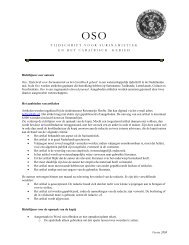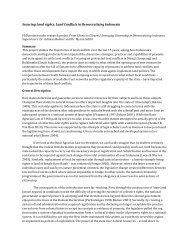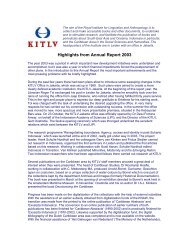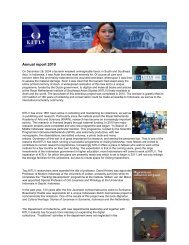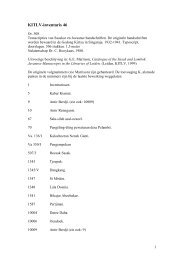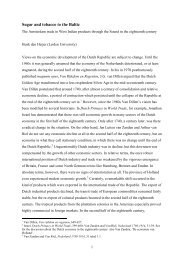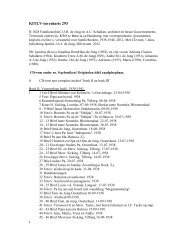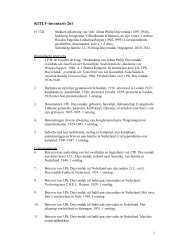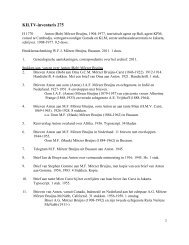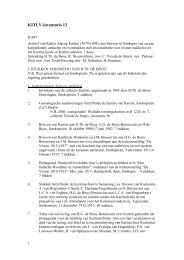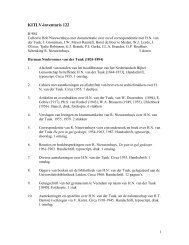The Acehnese past and its present state of study R. Michael ... - kitlv
The Acehnese past and its present state of study R. Michael ... - kitlv
The Acehnese past and its present state of study R. Michael ... - kitlv
Create successful ePaper yourself
Turn your PDF publications into a flip-book with our unique Google optimized e-Paper software.
Aceh as a fi eld for ancient history studies 29<br />
Chinese sources made mention <strong>of</strong> the country <strong>of</strong> Lan-wou-Li or Lan-Li, two<br />
toponyms that may be Sinicized forms <strong>of</strong> Lamri (Kévonian 1998, 2002). Lamri<br />
again appears among the settlements mentioned by Marco Polo at the end <strong>of</strong><br />
the thirteenth century (Polo 1955:242). During the fourteenth century, it was<br />
mentioned by Odoric de Pordenone (Bressan 1997:17), then in the Javanese<br />
text Nāgara-kĕrtāgama, dated 1365 (Pigeaud 1960:11). At the beginning <strong>of</strong> the<br />
fi fteenth century, Ma Huan, writing on the great maritime expeditions <strong>of</strong> the<br />
Ming dynasty in Southeast Asia <strong>and</strong> in the Indian Ocean, made mention <strong>of</strong><br />
Nan-p’o-Li (Ma Huan 1997:122-4). Thus, between the ninth century <strong>and</strong> the<br />
beginning <strong>of</strong> the sixteenth century we have a toponym, or a group <strong>of</strong> very<br />
closely related toponyms, identifi able at the tip <strong>of</strong> Aceh. It is possible that we<br />
are dealing with several contemporary <strong>and</strong> more or less connected harbours,<br />
which alternately dominated the region at various times. It is almost certain<br />
that the discoveries made in the Lambaro <strong>and</strong> Krueng Raya bays are related<br />
to this group <strong>of</strong> toponyms. 4<br />
<strong>The</strong>se sites have thus far been little researched. Another complicated case<br />
is <strong>present</strong>ed by the textual evidence for early settlements further down on the<br />
east coast. Pedir, close to the <strong>present</strong> town <strong>of</strong> Sigli, was, at the beginning <strong>of</strong> the<br />
sixteenth century, a major pepper producer visited by ships from Corom<strong>and</strong>el,<br />
Gujarat <strong>and</strong> Bengal. Barros, a Portuguese <strong>of</strong>fi cial historian, described it as the<br />
largest kingdom <strong>of</strong> the region, which was said to have been founded well<br />
before Melaka, dating back to at least the thirteenth century (Dion 1970:145).<br />
A twelfth-century Armenian text made mention <strong>of</strong> the towns <strong>of</strong> Samwi <strong>and</strong><br />
K’roudayi, tentatively located near Lhokseumawe <strong>and</strong> Pasai, respectively<br />
(Kévonian 1998:80-6, 2002:63-7). At the end <strong>of</strong> the thirteenth century Marco<br />
Polo made mention <strong>of</strong> the trading centres <strong>of</strong> Basman, in the environs <strong>of</strong><br />
Samudra, <strong>and</strong> Dagroian, between Samudra <strong>and</strong> Lambri (Polo 1955:242-3), <strong>and</strong><br />
the mid-fourteenth-century Javanese text Nāgara-kĕrtāgama made mention<br />
<strong>of</strong> Tumihang, whose name survives today as the name <strong>of</strong> a local river <strong>and</strong><br />
the town <strong>of</strong> Tanjung Tamiang near Langsa (Pigeaud 1960:11). Parlak, close<br />
to <strong>present</strong>-day Peureulak, was also mentioned in the Nāgara-kĕrtāgama, <strong>and</strong><br />
appears to be identical with Ferlec, as noted by Marco Polo, <strong>and</strong> perhaps also<br />
the town <strong>of</strong> Pourē mentioned in the twelfth-century Armenian text (Kévonian<br />
1998:86-8, 2002:67-70; Pigeaud 1960:11; Polo 1955:242-3). Other sites mentioned<br />
in early extant sources include Aeilabu, an independent kingdom that became<br />
a vassal <strong>of</strong> Pedir at the beginning <strong>of</strong> the sixteenth century. Pirada, comprising<br />
two neighbouring cities, was also a vassal <strong>of</strong> Pedir, but it emerged as <strong>its</strong> own<br />
kingdom at about the same time as when Pedir enjoyed close relations with<br />
the nearby kingdom <strong>of</strong> Lide (Cortesão 1990:140- 2).<br />
<strong>The</strong> west coast <strong>of</strong> Aceh also had settlements mentioned in some <strong>of</strong> these<br />
4 This hypothesis was fi rst suggested by McKinnon in 1988.




